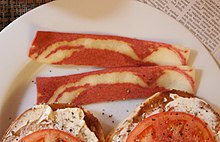
Back بدائل اللحوم Arabic Anàleg de la carn Catalan Náhražka masa Czech Fleischersatz German Υποκατάστατο κρέατος Greek Viand-anstataŭaĵo Esperanto Sucedáneo de carne Spanish Lihaasendajad Estonian شبهگوشت Persian Lihankorvike Finnish



A meat alternative or meat substitute (also called plant-based meat, mock meat, or fake meat sometimes pejoratively), is a food product made from vegetarian or vegan ingredients, eaten as a replacement for meat. Meat alternatives typically approximate qualities of specific types of meat, such as mouthfeel, flavor, appearance, or chemical characteristics.[1][2][3] Plant- and fungus-based substitutes are frequently made with soy (e.g. tofu, tempeh, and textured vegetable protein), but may also be made from wheat gluten as in seitan, pea protein as in the Beyond Burger, or mycoprotein as in Quorn.[4] Alternative protein foods can also be made by precision fermentation, where single cell organisms such as yeast produce specific proteins using a carbon source; as well as cultivated or laboratory grown, based on tissue engineering techniques.[5]
Meatless tissue engineering involves the cultivation of stem cells on natural or synthetic scaffolds to create meat-like products.[6] Scaffolds can be made from various materials, including plant-derived biomaterials, synthetic polymers, animal-based proteins, and self-assembling polypeptides.[7] It is these 3D scaffold-based methods provide a specialized structural environment for cellular growth.[8][9] Alternatively, scaffold-free methods promote cell aggregation, allowing cells to self-organize into tissue-like structures.[10]
Meat alternatives are typically consumed as a source of dietary protein by vegetarians, vegans, and people following religious and cultural dietary laws. However, global demand for sustainable diets has also increased their popularity among non-vegetarians and flexitarians seeking to reduce the environmental impact of meat production.
Meat substitution has a long history. Tofu was invented in China as early as 200 BCE,[11] and in the Middle Ages, chopped nuts and grapes were used as a substitute for mincemeat during Lent.[12] Since the 2010s, startup companies such as Impossible Foods and Beyond Meat have popularized pre-made plant-based substitutes for ground beef, patties, and vegan chicken nuggets as commercial products.
- ^ van der Weele, Cor; Feindt, Peter; Jan van der Goot, Atze; van Mierlo, Barbara; van Boekel, Martinus (2019). "Meat alternatives: an integrative comparison". Trends in Food Science and Technology. 88: 505–512. doi:10.1016/j.tifs.2019.04.018.
- ^ Nezlek, John B; Forestell, Catherine A (2022). "Meat substitutes: current status, potential benefits, and remaining challenges". Current Opinion In Food Science. 47: 100890. doi:10.1016/j.cofs.2022.100890.
- ^ Takefuji, Yoshiyasu (2021). "Sustainable protein alternatives". Trends in Food Science and Technology. 107: 429–431. doi:10.1016/j.tifs.2020.11.012.
- ^ Cite error: The named reference
Holmeswas invoked but never defined (see the help page). - ^ "All sizzle, no steak: how Singapore became the centre of the plant-based meat industry". The Guardian. 5 November 2022.
- ^ Ahmad, Khurshid; Lim, Jeong-Ho; Lee, Eun-Ju; Chun, Hee-Jin; Ali, Shahid; Ahmad, Syed Sayeed; Shaikh, Sibhghatulla; Choi, Inho (15 December 2021). "Extracellular Matrix and the Production of Cultured Meat". Foods. 10 (12): 3116. doi:10.3390/foods10123116. ISSN 2304-8158. PMC 8700801. PMID 34945667.
- ^ Rodrigues, André L.; Rodrigues, Carlos A. V.; Gomes, Ana R.; Vieira, Sara F.; Badenes, Sara M.; Diogo, Maria M.; Cabral, Joaquim M.S. (15 October 2018). "Dissolvable Microcarriers Allow Scalable Expansion And Harvesting Of Human Induced Pluripotent Stem Cells Under Xeno-Free Conditions". Biotechnology Journal. 14 (4): e1800461. doi:10.1002/biot.201800461. ISSN 1860-6768. PMID 30320457.
- ^ Moroni, Lorenzo; Burdick, Jason A.; Highley, Christopher; Lee, Sang Jin; Morimoto, Yuya; Takeuchi, Shoji; Yoo, James J. (26 April 2018). "Biofabrication strategies for 3D in vitro models and regenerative medicine". Nature Reviews Materials. 3 (5): 21–37. Bibcode:2018NatRM...3...21M. doi:10.1038/s41578-018-0006-y. ISSN 2058-8437. PMC 6586020. PMID 31223488.
- ^ Daly, Andrew C.; Kelly, Daniel J. (8 January 2019). "Biofabrication of spatially organised tissues by directing the growth of cellular spheroids within 3D printed polymeric microchambers". Biomaterials. 197: 194–206. doi:10.1016/j.biomaterials.2018.12.028. PMID 30660995.
- ^ Alblawi, Adel; Ranjani, Achalla Sri; Yasmin, Humaira; Gupta, Sharda; Bit, Arindam; Rahimi-Gorji, Mohammad (20 October 2019). "Scaffold-free: A developing technique in field of tissue engineering". Computer Methods and Programs in Biomedicine. 185: 105148. doi:10.1016/j.cmpb.2019.105148. PMID 31678793.
- ^ Cite error: The named reference
soywas invoked but never defined (see the help page). - ^ Cite error: The named reference
medwas invoked but never defined (see the help page).
© MMXXIII Rich X Search. We shall prevail. All rights reserved. Rich X Search